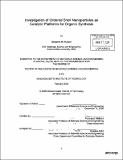Investigation of ordered shell nanoparticles as catalytic platforms for organic synthesis
Author(s)
Wunsch, Benjamin H. (Benjamin Hardy)
DownloadFull printable version (22.87Mb)
Other Contributors
Massachusetts Institute of Technology. Dept. of Materials Science and Engineering.
Advisor
Francesco Stellacci.
Terms of use
Metadata
Show full item recordAbstract
By observing the molecular structure of nature, the field of nanotechnology is exploring the significant versatility and complexity of the local, molecular environment. Through the careful positioning of the components of atoms and molecules into well-defined patterns or structures, unique properties and functions can be developed that are not obtainable by the basic components alone. This structure of the local environment is deeply important to catalysis, in which the catalyst affects a chemical transformation without being consumed itself. In pursuit of control over local molecular structure, previous work has discovered a general, spontaneous ordering of long, aliphatic molecules on the surfaces of nanoparticles. This ordering generates stripe-like domains, termed ripple domains, which have widths less than a nanometer and well-defined spatial separations. This structuring reminds us of the sub-nanometer ordering seen in biological enzymes, and we seek to investigate catalytic reactions occurring at the interface of the ripple domain interface as a possible new method in organic synthesis. Using nanoparticles as my chosen platform for the ripple domain, I have conducted research to test the hypothesis that the local ordering in the ripple domain shell can improve the catalytic rate of reaction. I am guided by recent evidence that the unique ripple domain morphology can cause ordering in the solvation shell that surrounds the nanoparticle, and thus alter the surface energy observed on the interface. Our investigation has found that when ripple domain gold-core nanoparticles synthesized with an imidazole terminated ligand are used in the general acid-base hydrolysis of an aromatic ester that the catalytic rate is modulated by the presence of the ripple domain, however the degree of modulation varies substantially between synthetic batches, preventing a conclusion of any statistical significance on the ability of the ripple domain to influence the catalytic reactivity. In mixed ethanol: water solvent I find that the ripple domain can modulate the catalyst rate in a non-monotonic manner, and when compared to a homo-ligand non-ripple catalyst particle, the modulated catalyst rate can be either enhanced or attenuated depending on the ligand ratio used. In pure water, non-ripple, homo-ligand catalyst particles have higher catalytic rates than ripple-domain particles; however the binding constant and attempt frequency of these types of particles is modulated by changes in the ripple domain, and provides evidence that the monolayer structure is affecting catalysis by producing a local environment capable of holding a reactive intermediate state. The results provide a beginning link between nanoparticle monolayer morphology and catalysis, and open the way to developing nanoparticles as selective catalysts based on changes in the structure of the monolayer.
Description
Thesis (Ph. D.)--Massachusetts Institute of Technology, Dept. of Materials Science and Engineering, 2009. Includes bibliographical references.
Date issued
2009Department
Massachusetts Institute of Technology. Department of Materials Science and EngineeringPublisher
Massachusetts Institute of Technology
Keywords
Materials Science and Engineering.